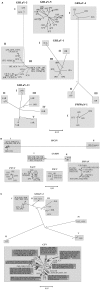Genetic variability and evolutionary dynamics of viruses of the family Closteroviridae
- PMID: 23805130
- PMCID: PMC3693128
- DOI: 10.3389/fmicb.2013.00151
Genetic variability and evolutionary dynamics of viruses of the family Closteroviridae
Abstract
RNA viruses have a great potential for genetic variation, rapid evolution and adaptation. Characterization of the genetic variation of viral populations provides relevant information on the processes involved in virus evolution and epidemiology and it is crucial for designing reliable diagnostic tools and developing efficient and durable disease control strategies. Here we performed an updated analysis of sequences available in Genbank and reviewed present knowledge on the genetic variability and evolutionary processes of viruses of the family Closteroviridae. Several factors have shaped the genetic structure and diversity of closteroviruses. (I) A strong negative selection seems to be responsible for the high genetic stability in space and time for some viruses. (2) Long distance migration, probably by human transport of infected propagative plant material, have caused that genetically similar virus isolates are found in distant geographical regions. (3) Recombination between divergent sequence variants have generated new genotypes and plays an important role for the evolution of some viruses of the family Closteroviridae. (4) Interaction between virus strains or between different viruses in mixed infections may alter accumulation of certain strains. (5) Host change or virus transmission by insect vectors induced changes in the viral population structure due to positive selection of sequence variants with higher fitness for host-virus or vector-virus interaction (adaptation) or by genetic drift due to random selection of sequence variants during the population bottleneck associated to the transmission process.
Keywords: Ampelovirus; Closterovirus; Crinivirus; gene flow; phylogeny; recombination; selection.
Figures

Similar articles
-
High-Throughput Sequencing Assists Studies in Genomic Variability and Epidemiology of Little Cherry Virus 1 and 2 infecting Prunus spp. in Belgium.Viruses. 2019 Jun 29;11(7):592. doi: 10.3390/v11070592. Viruses. 2019. PMID: 31261922 Free PMC article.
-
Populations of genomic RNAs devoted to the replication or spread of a bipartite plant virus differ in genetic structure.J Virol. 2009 Dec;83(24):12973-83. doi: 10.1128/JVI.00950-09. Epub 2009 Sep 30. J Virol. 2009. PMID: 19793810 Free PMC article.
-
Viromics unveils extraordinary genetic diversity of the family Closteroviridae in wild citrus.PLoS Pathog. 2021 Jul 12;17(7):e1009751. doi: 10.1371/journal.ppat.1009751. eCollection 2021 Jul. PLoS Pathog. 2021. PMID: 34252150 Free PMC article.
-
Determinants of Virus Variation, Evolution, and Host Adaptation.Pathogens. 2022 Sep 13;11(9):1039. doi: 10.3390/pathogens11091039. Pathogens. 2022. PMID: 36145471 Free PMC article. Review.
-
Comparative and functional genomics of closteroviruses.Virus Res. 2006 Apr;117(1):38-51. doi: 10.1016/j.virusres.2006.02.002. Epub 2006 Mar 9. Virus Res. 2006. PMID: 16529837 Free PMC article. Review.
Cited by
-
Genetic Variation and Evolutionary Analysis of Eggplant Mottled Dwarf Virus Isolates from Spain.Plants (Basel). 2024 Jan 16;13(2):250. doi: 10.3390/plants13020250. Plants (Basel). 2024. PMID: 38256804 Free PMC article.
-
Genomic analysis of Sweet potato feathery mottle virus from East Africa.Physiol Mol Plant Pathol. 2020 Apr;110:101473. doi: 10.1016/j.pmpp.2020.101473. Physiol Mol Plant Pathol. 2020. PMID: 32454559 Free PMC article.
-
The Temporal Order of Mixed Viral Infections Matters: Common Events That Are Neglected in Plant Viral Diseases.Viruses. 2024 Dec 20;16(12):1954. doi: 10.3390/v16121954. Viruses. 2024. PMID: 39772260 Free PMC article. Review.
-
Virome Profiling, New Virus Identification and the Prevalence and Distribution of Viruses Infecting Chieh-Qua (Benincasa hispida Cogn. var. chieh-qua How) in China.Viruses. 2023 Jun 19;15(6):1396. doi: 10.3390/v15061396. Viruses. 2023. PMID: 37376695 Free PMC article.
-
Emerging and population analysis of Grapevine Pinot gris virus isolates from Iran.3 Biotech. 2021 Aug;11(8):368. doi: 10.1007/s13205-021-02914-5. Epub 2021 Jul 7. 3 Biotech. 2021. PMID: 34295608 Free PMC article.
References
-
- Alavi V., Khatabi B., Salekdeh G. (2005). Comparison of biologically distinct isolates of Citrus tristeza virus from Iran using major coat protein sequences. Australas. Plant Pathol. 34, 577–582 10.1071/AP05079 - DOI
LinkOut - more resources
Full Text Sources
Other Literature Sources

